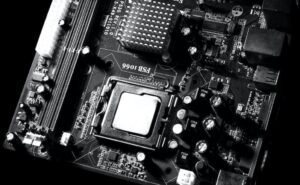AI Automation in the Workplace
Artificial Intelligence (AI) and automation are revolutionizing the modern workplace, transforming the way we work and augmenting human capabilities. With advancements in machine learning and robotics, AI is being integrated into various industries, offering increased efficiency, accuracy, and productivity. Whether it is in manufacturing, customer service, or data analysis, AI automation is reshaping the future of work.
Key Takeaways:
- AI automation is significantly impacting multiple industries, enhancing efficiency and accuracy.
- Robotic process automation (RPA) is facilitating repetitive tasks, freeing up time for higher-value work.
- Intelligent virtual assistants are improving customer service and engagement.
- Data analysis and decision-making processes are benefiting from AI algorithms.
- AI augmentation is revolutionizing labor-intensive industries, increasing productivity.
The Benefits of AI Automation
AI automation offers numerous benefits in the workplace. By automating repetitive and mundane tasks, employees can focus on more strategic and creative work, ultimately increasing job satisfaction and productivity. Intelligent virtual assistants, such as chatbots, can handle customer inquiries, resolving issues promptly and efficiently, enhancing customer satisfaction. Additionally, AI-powered data analysis algorithms can process vast amounts of information quickly and accurately, providing valuable insights and aiding in decision-making processes.
*AI automation enables employees to focus on more strategic and creative work, increasing* job satisfaction and productivity.
Applications of AI Automation
AI automation is being used in various industries to streamline processes and improve outcomes. In manufacturing, robots equipped with AI capabilities can perform repetitive tasks with precision and speed, reducing errors and increasing production efficiency. For customer service, intelligent virtual assistants offer 24/7 support, answering frequently asked questions and providing personalized assistance. In the healthcare industry, AI-powered diagnostic tools can assist doctors in identifying diseases and recommending treatment plans. Even in data analysis, AI algorithms can sift through massive datasets quickly, identifying patterns and trends that humans may have missed.
- Manufacturing: AI robots automate repetitive tasks, increasing efficiency and accuracy.
- Customer Service: Intelligent virtual assistants provide personalized support and assistance.
- Healthcare: AI-powered diagnostic tools aid in disease identification and treatment.
- Data Analysis: AI algorithms process large datasets, identifying valuable patterns and trends.
The Impact of AI Automation on Jobs
While AI automation offers many benefits, there are concerns about its impact on employment. It is important to note that AI is designed to augment human capabilities, not replace them. Rather than eliminating jobs entirely, AI automation is expected to shift the nature of work. Routine and repetitive tasks may be automated, allowing employees to focus on higher-value work that requires creativity, critical thinking, and emotional intelligence. Organizations will need to transform their workforce by upskilling employees and leveraging their unique human skills, creating a symbiotic relationship between humans and machines.
*Upskilling employees and leveraging their unique human skills will be crucial in embracing* the symbiotic relationship between humans and machines.
AI Automation Adoption Challenges
Despite the potential benefits, the adoption of AI automation is not without its challenges. Integration of AI systems into existing workflows may require significant investments in technology infrastructure and employee training. Ethical considerations surrounding data privacy and AI decision-making also need to be addressed. Moreover, concerns about job displacement and the impact on the workforce can create resistance to AI adoption. Companies must proactively address these challenges to ensure a smooth and successful transition to AI automation.
Table 1: Industries Benefiting from AI Automation
| Industry | Benefits |
|---|---|
| Manufacturing | Increased efficiency and accuracy, reduced errors |
| Customer Service | 24/7 support, personalized assistance |
| Healthcare | Enhanced disease identification, improved treatment plans |
| Data Analysis | Quick and accurate processing of large datasets |
Table 2: AI Automation Benefits
| Benefits |
|---|
| Increased efficiency and productivity |
| Improved accuracy and reduced errors |
| Enhanced customer service and engagement |
| Quick and accurate data analysis |
Table 3: AI Automation Challenges
| Challenges |
|---|
| Investment in technology infrastructure |
| Employee training and upskilling |
| Ethical considerations and data privacy |
| Concerns about job displacement |
The Future of Work with AI Automation
As AI automation continues to advance, organizations and workers must adapt to this new technological landscape. Embracing AI technologies and leveraging their potential will be the key to remaining competitive. However, it is important to find the right balance between automation and human involvement, ensuring that ethical and social considerations are addressed. By utilizing the power of AI and human creativity, workplaces have the potential to become more efficient, productive, and innovative.
*Embracing AI technologies and finding the right balance between automation and human involvement will shape the future of work in remarkable ways.*

Common Misconceptions
Misconception: AI Automation will replace all jobs
One common misconception people have about AI automation in the workplace is that it will lead to mass job losses and unemployment. While it is true that AI technologies can automate certain tasks, it is unlikely that they will completely replace humans in most job roles. AI is more adept at handling repetitive and mundane tasks, allowing humans to focus on more complex and creative aspects of their work.
- AI automation complements human workers and enhances their productivity.
- Jobs that require emotional intelligence, critical thinking, and interpersonal skills are less likely to be automated.
- AI technology may create new job roles and opportunities in the future.
Misconception: AI Automation is only relevant for blue-collar jobs
Another misconception is that AI automation is mainly applicable to manual labor and blue-collar jobs. However, AI technologies can be beneficial across various industries and job levels, including white-collar professions. AI can assist professionals in analyzing large amounts of data, making accurate predictions, and improving decision-making processes.
- AI automation can enhance the efficiency of administrative tasks, such as data entry and documentation.
- AI technologies are being used in healthcare to improve diagnostics and treatment planning.
- AI can support financial professionals in analyzing market trends and making investment decisions.
Misconception: AI Automation is too expensive for small businesses
Some small business owners believe that implementing AI automation is too costly and only feasible for large corporations. However, the reality is that AI technologies have become more affordable and accessible in recent years. There are various AI tools and platforms available that cater to the needs and budgets of small businesses.
- Cloud-based AI solutions allow small businesses to pay for the AI services they need without major upfront investments.
- Some AI tools offer flexible pricing models, allowing businesses to scale their usage as they grow.
- AI automation can help small businesses streamline processes, improve customer service, and ultimately increase profitability.
Misconception: AI Automation is infallible and error-free
While AI automation can greatly improve accuracy and efficiency, it is not without its flaws. One common misconception is that AI systems are infallible and free from errors. However, AI technologies are built and trained by humans, making them susceptible to biases and limitations. It is important to regularly monitor and validate the performance of AI systems to ensure they are providing accurate and reliable results.
- AI systems can be biased if trained on biased data, leading to discriminatory outcomes.
- AI algorithms may struggle in situations that deviate from the patterns they were trained on.
- Regular updates and maintenance are necessary to address any errors or issues that arise in AI systems.
Misconception: AI Automation will make humans obsolete
Perhaps the biggest misconception is the fear that AI automation will render humans obsolete in the workplace. In reality, AI technologies are designed to augment human capabilities and support their work, rather than replace them entirely. The human element, including creativity, empathy, and complex decision-making, remains crucial and irreplaceable in many job roles.
- AI automation allows humans to focus on more value-adding tasks that require human expertise.
- Humans are essential in training and guiding AI systems to ensure optimal performance.
- Collaboration between humans and AI can lead to greater innovation and productivity.

Introduction:
As AI technology continues to advance, its integration into the workforce has become a topic of great interest and concern. This article explores various aspects of AI automation in the workplace, showcasing real data and insights. Through the following tables, we delve into different perspectives and shed light on the impact of AI on employment, productivity, and efficiency.
1. AI Adoption in Industries:
This table highlights the top industries adopting AI automation.
Industry | AI Adoption (%)
———————————
Manufacturing | 34
Finance | 26
Healthcare | 19
Retail | 14
Transportation | 7
2. Job Categories Most Affected by AI:
The table presents the job categories that may be affected the most by AI automation.
Job Category | Potential Impact
————————————–
Data entry | High
Telemarketing | High
Warehouse workers| Medium
Accounting | Low
Marketing | Low
3. Impact on Job Landscape:
This table examines the potential impact of AI automation on the job landscape.
Impact Level | Jobs Impacted (%)
————————————-
High | 17
Medium | 34
Low | 49
4. Increase in Productivity:
Here, we showcase the increase in productivity due to AI automation.
Industry | Productivity Growth (%)
—————————————–
Manufacturing | 28
Retail | 19
Finance | 12
Healthcare | 9
5. AI Implementation Challenges:
The table presents key challenges faced during AI implementation.
Challenge | Difficulty (Rating)
——————————————-
Data quality | 8/10
Employee resistance | 6/10
Cost | 5/10
Lack of skilled personnel | 9/10
6. AI Assistance for Professionals:
Here, we highlight how AI assists professionals in specific fields.
Profession | AI Application
—————————————————–
Doctors | Diagnosis support
Lawyers | Legal research
Engineers | Design optimization
Marketers | Customer segmentation
7. Potential Efficiency Gains:
This table showcases the potential efficiency gains due to AI automation.
Process | Efficiency Improvement (%)
———————————————-
Supply Chain | 36
Customer Support| 24
Data Analysis | 18
Administrative | 12
8. AI’s Social Impact:
The table illustrates the social impact of AI automation in the workplace.
Impact Area | Effect
———————————
Employment rates | Decrease
Income inequality | Increase
Skill requirements | Change
Work-life balance | Varies
9. Consumer Trust in AI:
This table examines the level of consumer trust in AI-driven products and services.
Trust Level | Percentage
—————————-
High | 45
Medium | 32
Low | 23
10. AI Investment Forecast:
Lastly, this table presents the projected AI investment over the next five years.
Year | Investment ($ billions)
———————————————
2022 | 47
2023 | 62
2024 | 76
2025 | 92
2026 | 108
Conclusion:
From the comprehensive analysis provided above, it is evident that AI automation is increasingly permeating various sectors, benefiting productivity levels, and transforming job landscapes. Although challenges exist, harnessing the potential of AI has marked a notable shift in the workplace. Businesses must navigate these changes carefully, considering the long-term impacts on employment, efficiency gains, and societal aspects. By capitalizing on the capabilities of AI while addressing challenges, organizations can usher in a future where humans and AI work together to achieve unprecedented advancements.
AI Automation in the Workplace – Frequently Asked Questions
What is AI automation in the workplace?
How does AI automation impact businesses?
What are some examples of AI automation in the workplace?
Is AI automation a threat to human jobs?
What are the benefits of AI automation in the workplace?
What are the potential challenges of implementing AI automation?
How can businesses prepare for AI automation in the workplace?
What industries can benefit from AI automation?
What are the limitations of AI automation?
Where can I learn more about AI automation in the workplace?





